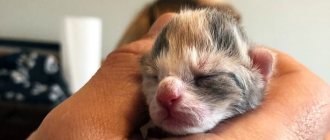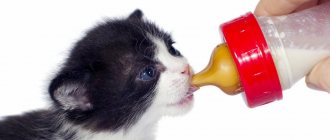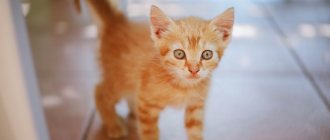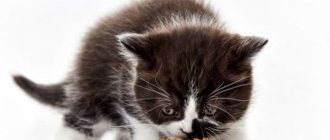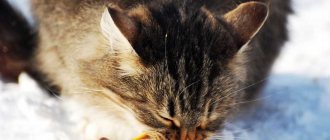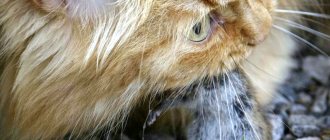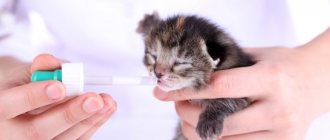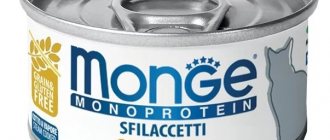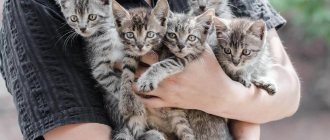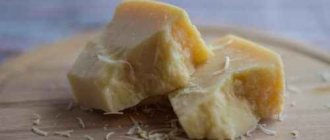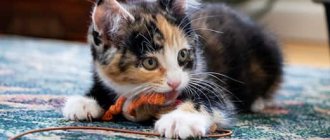In the article, we looked at the questions that owners have when introducing complementary foods to kittens. What is the best time to start complementary feeding, how and what to feed newborn kittens and kittens from one to three months. From the material you will learn which foods are prohibited for kittens to eat and why water is important for the health of the animal.
For the first three to four weeks of life, kittens feed on the milk of their mother cat. But over time, it becomes insufficient to develop properly, grow healthy and strong. At about the age of one month, kittens need to be introduced to complementary foods, which means they should begin to accustom them to adult food.
In order for kittens to grow up healthy and strong, you need to introduce complementary foods
Optimal time to start complementary feeding
Owners often have questions about when to start feeding kittens and what is best to feed them – natural food or ready-made industrial food.
Complementary foods can be introduced into the diet of kittens 20-21 days after birth. This procedure must be carried out up to six times a day, every 3-4 hours. Complementary feeding for kittens is usually started simultaneously with the consumption of mother's milk. Food is an addition; it must be soft, warm, and the portions are small, because babies have not yet learned to chew.
If you plan to feed your cat dry food in the future, you can make a paste out of it and give it to the kittens. The store sells special food for tailed babies of different breeds. Several pads are soaked in water and carefully spread on the kitten’s palate. Then a bowl of food soaked in water is placed in front of him. Gradually he must understand what is required of him. The amount of water added to the food should be gradually reduced, and by two months the baby will be able to chew the pads on his own.
Acana and Orijen: biologically appropriate diets for kittens
All Champion Petfoods foods are complete, biologically appropriate, contain a high proportion of fresh meat and natural nutritional supplements, making them suitable for feeding cats of all ages.
- Acana dry food is represented by three products: based on free-range poultry meat (chickens, turkeys, ducks), farm lamb and freshly caught ocean fish. Their composition fully meets the requirements for the feeding diet of kittens: the proportion of meat components is 75%, fat content is 20%, the formula contains pre- and probiotics. The balance of minerals, vitamins and other beneficial substances meets AAFCO standards. The size of the granules is about 10 mm. If your kitten is very tiny, you can grind them a little at first, however, this size does not cause any problems for pets older than 2 months.
- The Orijen line has no less advantages than Acana, only the share of meat components reaches 85%. In addition, Orijen also offers a special diet for kittens , in which the granules are slightly smaller - 8 mm each. It is created from meat and offal of turkey, chicken, sardines, flounder - the composition, if you look, is extremely rich.
According to the Acana and Orijen food tables, small kittens (up to 20 weeks) should be given 60 g of dry food per 1 kg of weight, and then gradually reduce the norm and reach a dosage of 30 g per kg of weight by six months. You will understand that you need to reduce the portions if, after 24 hours, there are still some granules left in the bowl.
How to feed artificially
Sometimes cats, for some reason, abandon their kittens; they may not have milk to feed; tiny kittens can be found on the street or in the entrance. This is very dangerous for the lives of small animals, so you need to provide the kittens with care, care and proper feeding.
Only a human can help a defenseless kitten
Portion calculation
Complementary feeding for kittens left without a mother can be done using dry formulas that replace cat's milk, which are sold in pharmacies, or you can prepare a liquid mixture from natural products.
Milk replacers are sold in powdered and liquid forms. The powder is diluted with water as indicated on the packaging by the manufacturer. The unused portion is stored in the refrigerator. The mixture should not be allowed to freeze.
In the first seven days, the daily norm is 30 ml of formula per 100 grams of kitten weight. Further, until the age of two weeks, the amount of food increases to 40 ml per 100 grams of weight.
To replace cat milk, you can prepare several mixtures yourself:
- Dilute 250 grams of cream with 10% fat content with warm water in a ratio of 1 to 2;
- Mix a portion of goat milk with egg white in a ratio of 4 to 1 until smooth;
- Dilute condensed milk without sugar with water in a ratio of 5 to 1, add a teaspoon of bone meal to the mixture.
Raw cow's milk is contraindicated for newborn kittens; digestive problems may occur. You can use goat's milk for complementary feeding.
You can prepare your own formula for complementary feeding
Starting from the eighth day, kittens should be given liquid vitamin preparations prescribed by a veterinarian every other day.
The best food option for kittens is to use specially formulated cat milk replacers. The use of these mixtures practically guarantees the absence of problems with intestinal microflora in the future.
Rules for introducing complementary foods
There are general rules for feeding kittens that must be followed:
- Kittens are fed only in a prone position (natural) or held upright (with a weakened sucking reflex). A kitten may choke if placed on its back.
- Strictly control the gradual flow of the mixture, as the kitten may inhale excess liquid.
- You can feed using a pipette or a medical syringe without a needle. It is best to purchase a special bottle with a pacifier for kittens.
- The bottle should be held at a comfortable angle for the kitten, but not vertically or horizontally. The angle is approximately 45 degrees.
- After feeding, you need to massage the kitten's belly with a moistened piece of cloth or a damp sponge to stimulate digestion. This step cannot be skipped, because the kitten will not be able to go to the toilet and will suffer from intoxication. Under normal conditions, this is done by the mother cat. The kitten should relieve its natural needs 2-3 times a day.
- It takes about 5 minutes for a kitten to eat. If he sucks sluggishly and begins to fall asleep, it means he is full.
- Never force-feed leftover formula, even if your baby doesn't seem to have eaten enough. It is better to take a break and offer the pacifier again after 30–40 minutes.
- It is necessary to pay attention to the temperature of the food. Cold food disrupts digestion, hot food burns the oral cavity. From the first days of feeding, the temperature should be 37 degrees - an approximate indicator for the kitten’s body. Every week you need to lower this degree. By the end of the month, the mixture should be at room temperature - 24 degrees.
- Pipettes or bottles must be sterile; to do this, they must be boiled regularly.
It is better to feed babies with a bottle
Kittens' weight needs to be monitored. Slow growth indicates that the animals are malnourished. If kittens begin to suck the finger extended to them and squeak all the time, then they are hungry. Until about three weeks of age, they should gain 10-15 grams every day.
How often to give complementary foods
Kittens' diet changes almost every day. When feeding kittens with cat milk substitute formulas, you must follow the instructions on the package. Generalized recommendations for feeding frequency and portion sizes are as follows:
Days 1-4, the amount of mixture is 30 ml per 100 grams of weight every two hours around the clock.
Days 5-13, the amount of mixture is 38 ml per 100 grams of weight every 4 hours.
14-24 days the amount of mixture is 46 ml per 100 grams of weight every 4 hours. Formula milk can be poured into a saucer to encourage kittens to lap on their own. From the 15th day, kittens can be fed additionally.
25-35 days amount of food 53 ml per 160 grams of weight. During this period, it is necessary to feed the kittens with other foods and introduce solid food.
Failure to adhere to the feeding schedule can lead to health problems.
How much food to give kittens?
Probably everyone has heard the phrase “A kitten’s stomach is no bigger than a thimble.” This is not entirely true, because at the age when the baby enters the family, and it is advisable that this happens no earlier than 3 months, the volume of his stomach is about 40 ml and resembles a small pile. But this is still very little, so kittens need to be fed in small portions, but often. If the pet has eaten and stopped, most likely there is no “room” left, but as soon as the food is digested, the baby will be hungry again, and this will happen very quickly!
The fact is that the energy needs of cubs are very high, they are an order of magnitude higher than those of adult animals, so the diet of kittens should not be empty and dietary, but extremely saturated - contain a maximum of useful substances and “building material”. Only then will the kitten truly eat, grow and develop.
From birth to one year, a kitten increases its body weight by 40-50 times (for example: a human child - on average, 15-20 times). Up to 2 months, he needs about 220 kcal per kg of body weight, then the norm decreases and by the year reaches 45–50 kcal per kg of weight.
However, overfeeding is also not a completely correct practice. This is fraught with gastrointestinal disorders, as well as the appearance of excess weight, which puts stress on the growing joints of kittens and is especially dangerous for large breeds, such as Maine Coons. What to do?
- Acana food packages, as well as other wet and dry industrial food, must contain a table with feeding standards - follow them. Dosages of canned food are usually indicated in bags (pouches), and for dry food - in grams. It is advisable to use a scale or measuring cup.
- Weigh the kitten from time to time in order to adjust the portions in time (over the course of a week, its weight should increase by at least 50 g, and preferably by 100 g or even more for large breeds).
If there is no weight gain, it is likely that the kitten’s diet is low in nutrition or you are underfeeding it. Of course, this is only true if the animal is healthy and not infected with parasites. Analyze the kitten's menu and show it to the veterinarian.
What to include in your diet
From the very first days of complementary feeding, owners need to choose a method of feeding the kitten and constantly adhere to it. In no case should you alternate natural products and industrial feeds - in this case it is impossible to maintain the optimal balance of vitamins and minerals, and an excess of any element can be no less harmful than its deficiency.
Throughout the cat’s life, you need to adhere to the feeding method chosen in childhood.
Diet of a kitten aged 1-1.5 months
Food for a 1 month old kitten should be similar in consistency to milk. Avoid hard foods and large pieces. The pet's body simply cannot digest such food.
New foods should be introduced into the diet every two to three days. The product is introduced gradually and in small portions.
Month-old kittens cannot control their food intake, so portion sizes must be observed. In addition, feeding too often can cause a negative reaction from the digestive system.
The list of products for a one-month-old kitten will be quite limited. The pet's jaws are not yet designed to chew large pieces of food, and the gastrointestinal tract is not able to digest many foods.
Veterinarians recommend starting complementary feeding for pets with liquid milk porridges, goat milk, low-fat cottage cheese, lean boiled meat or scraped raw meat.
At the age of 1-1.5 months, the average number of feedings per day should be 5-6 servings. For 100 grams of kitten weight you need to prepare 50-55 ml of prepared food.
In order to be sure that the kitten’s body receives all the necessary substances, you can buy additional vitamins and supplements. They should be selected after consultation with a veterinarian.
One-month-old kittens can be given goat's milk in small quantities.
A kitten that does not eat natural food should be fed high-quality ready-made food.
If the kitten will continue to eat ready-made dry or wet food, then it is necessary to start complementary feeding with them. Food must be chosen that is specialized for small kittens and takes into account the breed.
You need to start feeding kittens at three to four weeks of age. However, they must still receive breast milk or a milk substitute. Kittens need to be fed up to five times a day, every three to four hours. Portions should be small, and food should be warm and softened, since babies do not yet know how to chew.
Complementary feeding at 2 months of age
From two months, kittens can already eat more solid food. They still need to be fed 5-6 times a day in small portions.
At this time, the kitten’s diet may consist of liquid porridge (oatmeal, rice) cooked in milk, scraped meat, boiled vegetables (carrots, zucchini, pumpkin) in the form of puree or finely chopped with the addition of vegetable oil, kefir, cream, yogurt (natural , no additives or sugar).
The best meat for kittens at this age is lean beef, rabbit, chicken, and turkey. No more than once a week you can give offal: chicken and beef liver, heart. They are fed finely chopped or ground with porridge.
If you plan to switch kittens to dry or wet ready-made food, then this should be done after 2 months. The food must be of high quality and special for kittens.
Dry food should be specially selected for the age and breed of the kitten.
Nutrition for a 3 month old kitten
At three months of age, kittens’ skeletons become stronger, muscles grow, and teeth change. Kittens play and run a lot, exploring their surroundings. Therefore, they need an appropriate diet rich in nutrients and vitamins.
Three months is the age when it is time to finally switch the kitten to adult food. The number of feedings is reduced to 5 times a day.
The diet of a three-month-old kitten should include: raw meat (chicken, turkey, beef, rabbit), offal (liver, heart), porridge (oatmeal, buckwheat, rice), raw and boiled vegetables (carrots, cauliflower, zucchini, pumpkin), cream , kefir. You can introduce sea fish, no more than 2 times a month.
When choosing ready-made food, you should give preference to premium food. Food must be specially selected for the age and breed of the kitten.
Three month old kittens are very energetic and require a more nutritious diet.
Are there any peculiarities in feeding small kittens of different breeds?
Feeding different kittens may vary depending on the breed.
Caring for any breed has its own nuances. For example, it is not customary to give liver to babies of Russian Blue cats and Gray Nibelungs. It is believed that this product gives the fur a brown tint, although many breeders recommend feeding kittens with liver from at least one and a half months. It is recommended to feed British kittens a nutritious diet. Britons are stocky animals, kittens grow quickly, rapidly gaining weight, but these animals cannot be called lazy. The diet of such a kitten should contain at least 65% meat products, and vegetables - about 25–30%.
Scottish kittens (Scottish Folds and Scottish Straights) under 3 months of age should eat at least 6 times a day. Active cats quickly begin to feel hungry. Some owners of Scottish cats note that the more nutritiously you feed the kitten, the better its coat “fills up.” I had to read recommendations and advice on feeding Scottish cats on forums. One breeder wrote that the more difficult it is to prepare porridge (4-5 grains at a time), the thicker the animal’s fur becomes. And some even choose a mixed type of feeding. Moreover, kittens are given high-calorie foods as an additive to store-bought food.
I feed my Scottish dogs Royal Canin dry. Kittens are on Bebika, adults are on Fit 32. Plus frozen turkey beef. I also give quail eggs with cream to kittens.
kroin, regular visitor to the forum
https://forum-wec.com/index.php?showtopic=170823
Scots need to be fed often and nutritiously
There is a lot of controversy about the nutrition of small Maine Coons. However, every breeder recommends closely monitoring the baby’s diet. Cubs grow large; a three-month-old kitten can be the size of a regular adult cat. The food for such cats should be dense and plentiful, but the kitten should not be overfed (regular overfeeding leads to obesity and other problems).
To teach your Maine Coon to eat on his own: spoon the pate into his mouth. No bottles. Standards are based on weight, read on the food packaging. And no variety: chickens, etc. Nothing except dry meat and pate. The total number of feedings is 5 per day. Pate per feeding - from a teaspoon.
carrot, forum user
https://www.mainecoon-forum.ru/showthread.php?t=46147
With ready-made food, everything is much simpler. Manufacturers of elite baby food take into account the characteristics of breeds. For example, Royal Canin, which produces food for 6 different breeds of kittens, has developed the British Shorthair series. This food is presented in the form of large granules of a special curved shape. The busy British cannot swallow such an “inconvenient” faction; they have to chew it. In addition, the packages of store-bought food always indicate the daily intake for a kitten, the volume of a single serving and other details.
Video: Sphynx kitten wants to eat porridge along with a plate
Prohibited foods for the diet
It is recommended to exclude the following products from the kitten’s menu:
- milk and fatty dairy products;
- fried and salted foods;
- smoked meats and sausages;
- pork;
- River fish;
- potatoes, tomatoes, grapes, citruses, pineapple, kiwi;
- chocolate and bakery products;
- bones of animals, birds or fish;
- food from a person's table;
- dog food.
To prevent your kitten from eating prohibited foods, you need to follow these simple tips:
- Do not allow the kitten to sit on the table while preparing or eating food.
- Don't feed table scraps.
- During the holidays, be on your guard - scents can tempt even the most well-mannered and obedient animal.
- Keep food out of the kitten's reach. If he shows interest, install special locks on the cabinet doors.
Don't let the kitten sit on the table
Prolonged feeding of a kitten with human food leads to metabolic disorders, diseases of the gastrointestinal tract, heart and blood vessels.
Poor quality of the finished food or intolerance to a certain type can cause digestive problems in the kitten. In this case, you should consult a veterinarian and choose a different type of food or a different type and brand of food; it is better to give preference to products with a higher price. Saving on the animal's nutrition will negatively affect its health and will lead to even greater costs for the treatment of diseases that arise as a result of eating low-quality food.
The best food for kittens
Products marked premium or super premium are suitable for kittens.
The following manufacturers have developed special lines:
- Royal canin Mother and Babycat. The product is available in the form of dry and wet food, it can be used from 1 month, the granules quickly soften in liquid. The composition contains LIP proteins, they are easily digestible, probiotics support the microflora of the gastrointestinal tract.
- Pro plan junior . The composition includes 20% chicken meat, dry animal proteins, and the total amount of protein is up to 42%. Manufacturers have added the Optistart complex with cow colostrum; this component stimulates the formation of immunity and improves the microflora of the digestive system.
- Perfect fit Junior . The food contains 24% protein, but the manufacturers included dehydrated meat. The products are attractive because they are affordable and contain a full range of vitamins and minerals. Reviews about the product are contradictory.
- Hill's Science Plan Kitten . The line produces both wet mousse and dry granules. In the first place in the composition is chicken protein and turkey flour; the only plant components found are corn; natural preservatives are used for preservation.
- Eukanuba Cat Kitten. The amount of useful protein is 36%, it is represented by fresh poultry meat, chicken liver, and fish meal. There are no artificial ingredients in the products.
- Arden Grange Kitten. Proteins make up 34%, contains prebiotics and natural preservatives.
Holistic products are highly nutritious, but they are expensive and rarely found in Russian stores.
The health of a kitten directly depends on nutrition, so caring owners spare no time and money to feed the animal.
Water in the diet
The process of transitioning from cat milk or milk replacer involves gradually increasing your drinking water intake. Water is very important to keep kittens healthy and active. At about 4 weeks of age, as soon as the kittens begin to eat solid food, they need to have access to clean, fresh water.
It is advisable not to use a plastic bowl; it should be made of metal, glass or porcelain. It is better to place the bowl a little away from the place where the kittens eat. You can place several bowls of water throughout the apartment. A good solution would be to purchase a special drinking fountain.
Water is very important for a kitten's health
Selecting a diet for a one-month-old kitten
global $ads_google; //data-ad-slot=”2475549904″ $ads_google = empty($ads_google) ? false : true; ?> if ($ads_google == false) {?>
$ads_google = true; ?> } ?>
To choose the right diet for a 1-month-old kitten, you need to find out what you can feed it and how often to feed it. Among cat lovers, there is ongoing debate about what is better - natural food or ready-made food. To solve this problem, you need to proceed from what the future cat needs in order for it to grow up healthy, beautiful and strong. Manufacturers of dry food produce products designed for a specific age of a pet and the requirements of its body. Proponents of natural food also turn out to be right: all useful substances can be obtained from natural nutrition. In order not to make a mistake, you will have to make a choice in favor of one type of food or another - you cannot mix them.
Features of complementary feeding of individual breeds
When introducing complementary foods and preparing a diet, you need to take into account the characteristics of cat breeds. For most species, standard rules apply. But there are breeds that have certain characteristics that require correction in the complementary feeding regime.
Ragdoll kittens have a genetic disease: hypertrophic cardiomyopathy (thickening of one of the walls of the heart ventricle) and joint dysplasia. Therefore, the list of prohibited products additionally includes: meat of geese and ducks, cream, and fatty sour cream. Their consumption negatively affects cardiac activity and disrupts metabolism.
Little ragdolls
Sphynx kittens (like other representatives of hairless breeds) have a high risk of developing cardiovascular diseases. They can only be given dietary meat: turkey or chicken, rabbit, beef. Pork should not be given to any cats, and especially not to sphinxes. To start feeding, raw or boiled veal is suitable.
A Sphynx kitten needs to be fed more often than a regular cat. Six to eight meals are recommended up to two months, four meals up to five months. At the age of six months, reduce the frequency of feedings to three times a day, and from the age of nine months, accustom them to two meals a day.
Sphynx kittens
Maine Coons mature late. Cats usually feed their babies for up to two months. These kittens do not need to be fed complementary foods until they are 8 weeks old.
Maine Coon kittens differ from all others in their large size. Accordingly, more food is needed. At the age of two months, kittens should receive 130 grams of meat, up to 40 grams of vegetables and dairy products, and about 15 grams of cereal. For other breeds, this is the norm for an adult cat.
Maine Coon kittens are larger than kittens of other breeds
Feeding kittens with dry food
Industrial feeds have two advantages: they contain nutrients in the right quantities and proportions, and feeding does not take much time. Doctors' opinions on when to start complementary feeding differ. Some do not recommend dry food until two months.
Others advise preparing digestion for adult food from the age of one month, observing the following rules:
- Mother's milk or a milk substitute is left in the diet until the kitten is two months old.
- Do not mix industrial and natural products so as not to disrupt digestion.
- Dry food is introduced gradually and only in a softened form. On the first day, feed one lump, soak it in the mixture or kefir, knead it with a fork and put it in your mouth. The next day, the portion is increased to two granules, and gradually brought to the permitted volume. The amount of liquid for soaking is gradually reduced.
- The daily intake varies from 20 to 30 grams for different manufacturers; this is specified in the instructions.
- The daily volume is divided into equal parts and fed 3 times a day.
- They do not change the brand of food, but if gastric disorders or allergies begin, you will have to choose products from another manufacturer.
- Economy class food is not suitable, it does not contain enough nutritional components, and synthetic flavoring additives often cause allergies.
- Products are not suitable for adult cats.
- Additional vitamins are not given to prevent hypervitaminosis from developing.
More water is required than with natural nutrition, so its availability is monitored with double attention.
General recommendations
If it is decided that the kittens will eat only natural food, it is advisable to accustom the pets to eating a variety of foods from the first month. You should not give your animal one product he loves and make it the main one in his diet. This can lead to digestive problems.
A great danger to a kitten's health is feeding human food in combination with ready-made food. It is also not recommended to mix expensive dry food with cheap wet food. It is better to leave only dry food, since low-quality wet food will do nothing but harm to the kitten.
Pay attention to the kitten’s fur as often as possible: if it is shiny and smooth, then the pet is healthy. If bald spots appear or the skin under the fur is irritated, you need to consult a veterinarian and purchase a special vitamin complex. But remember that in a good ready-made food, all nutrients and microelements are already balanced.
Breast milk substitutes
A cat feeds kittens for an average of 2.5 months, and at 5 weeks the kitten continues to feed on mother’s milk.
If he is left without a cat, substitutes are used. The best option is considered to be special adapted mixtures that are sold in pet stores and veterinary pharmacies. They come with a container, nipple, measuring spoon and detailed instructions. The mixtures Royal, Gimpet, Beaphar have a successful composition. They contain all the beneficial substances in the correct ratio. If there is no special food, use formula for children from 0 to 6 months. When diluting the powder, add 1.5 times more water than indicated in the instructions. Cow's milk is allowed as a last resort if it is not possible to purchase ready-made food. It is boiled, cooled and mixed with the yolk to enrich it with vitamins.
The kitten is fed from a nipple, pipette or syringe without a needle, but is gradually taught to lap from a spoon and saucer. First, they offer to lick their finger, then carefully touch the mixture with their muzzle. When the kitten tastes it, he himself will reach for the bowl.
You might be interested in:
- What to feed a 2 month old kitten
- What to feed a half year old kitten
Features of nutrition and digestion in kittens
Newborn kittens receive from mother's milk all the substances necessary for development. Cow and goat are not suitable because they do not contain the required amount of fat, protein, calories, and amino acids.
The milk that newborn kittens receive from their mother on the first day after birth not only transfers nutrients. The liquid contains antibodies that help babies fight viruses and bacteria that are dangerous specifically for cats.
A few days after birth, the amount of protein and fat in cat's milk increases. The latter contribute to the development of the nervous system of babies. Towards the end of feeding, the composition of the liquid changes, preparing the baby’s body for the transition to wet, then solid food of a carnivore.
What should you not feed newborn kittens?
If you listen to the advice of experts, ignoring common sense, then it won’t take long for things to get into trouble. There are several “don’ts” in feeding newborn kittens, in addition to a strict feeding schedule, dosage and food intake rules.
- Cow's milk is not used in its pure form, as this can lead to severe indigestion and possible death.
- No cream, even diluted with water.
- Don’t rush and shove sausage or minced meat into your baby’s mouth.
- When the baby gets a little older, you also shouldn’t rush to feed him raw freshwater fish, otherwise he may be attacked by helminths.
